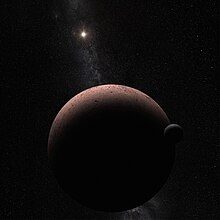/test-hindi/media/media_files/k8k2j91EsnIhK5Rxthx8.png)
Like Pluto, Makemake appears red in the visible spectrum, and significantly redder than the surface of Eris (see colour comparison of TNOs).<50> The near-infrared spectrum is marked by the presence of the broad methane (CH4) absorption bands. Methane is observed also on Pluto and Eris, but its spectral signature is much weaker.<50>
Spectral analysis of Makemake's surface revealed that methane must be present in the form of large grains at least one centimetre in size.<21> In addition to methane, large amounts of ethane and tholins as well as smaller amounts of ethylene, acetylene and high-mass alkanes (like propane) may be present, most likely created by photolysis of methane by solar radiation.<21><51> The tholins are probably responsible for the red color of the visible spectrum. Although evidence exists for the presence of nitrogen ice on its surface, at least mixed with other ices, there is nowhere near the same level of nitrogen as on Pluto and Triton, where it composes more than 98 percent of the crust. The relative lack of nitrogen ice suggests that its supply of nitrogen has somehow been depleted over the age of the Solar System.<21><52><53>
An artist's interpretation of the dwarf planet Makemake, depicted with its reddish surface and its moon
The far-infrared (24–70 μm) and submillimeter (70–500 μm) photometry performed by Spitzer and Herschel telescopes revealed that the surface of Makemake is not homogeneous. Although the majority of it is covered by nitrogen and methane ices, where the albedo ranges from 78 to 90%, there are small patches of dark terrain whose albedo is only 2 to 12%, and that make up 3 to 7% of the surface.<24> These studies were made before S/2015 (136472) 1 was discovered; thus, these small dark patches may actually have been the dark surface of the satellite rather than any actual surface features on Makemake.<54>
However, some experiments have refuted these studies. Spectroscopic studies, collected from 2005 to 2008 using the William Herschel Telescope (La Palma, Spain) were analyzed together with other spectra in the literature, as of 2014. They show some degree of variation in the spectral slope, which would be associated with different abundance of the complex organic materials, byproduct of the irradiation of the ices present on the surface of Makemake. However, the relative ratio of the two dominant icy species, methane and nitrogen, remains quite stable on the surface revealing a low degree of inhomogeneity in the ice component.<55> These results have been recently confirmed when the Telescopio Nazionale Galileo acquired new visible and near infra-red spectra for Makemake, between 2006 and 2013, that covered nearly 80% of its surface; this study found that the variation in the spectra were negligible, suggesting that Makemake's surface may indeed be homogenous.<56> Based on optical observations conducted between 2006 and 2017, Hromakina et al. concluded that Makemake's lightcurve was likely due to heterogeneities across its surface, but that the variations (of the order of 3%) were too small to have been detected spectroscopically.<14>
image widget
/test-hindi/media/agency_attachments/2025/04/09/2025-04-09t075510288z-original-4165ef475e94ba4104940d4cdab8f760.png)
 Follow Us
Follow Us